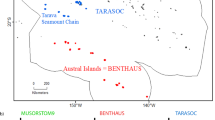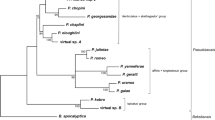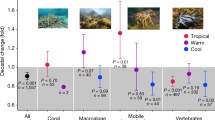Abstract
Seamounts comprise a unique deep-sea environment, characterized by substantially enhanced currents and a fauna that is dominated by suspension feeders, such as corals1,2,3,4. The potential importance of these steep-sided undersea mountains, which are generally of volcanic origin, to ocean biogeography and diversity was recognized over 40 years ago5, but this environment has remained very poorly explored. A review3 of seamount biota and biogeography reported a total of 597 invertebrate species recorded from seamounts worldwide since the Challenger expedition of 1872. Most reports, based on a single taxonomic group, were extremely limited: 5 seamounts of the estimated more than 30,000 seamounts in the world's oceans4,6 accounted for 72% of the species recorded. Only 15% of the species occurring on seamounts were considered potential seamount endemics. Here we report the discovery of more than 850 macro- and megafaunal species from seamounts in the Tasman Sea and southeast Coral Sea, of which 29–34% are new to science and potential seamount endemics. Low species overlap between seamounts in different portions of the region indicates that the seamounts in clusters or along ridge systems function as ‘island groups’ or ‘chains,’ leading to highly localized species distributions and apparent speciation between groups or ridge systems that is exceptional for the deep sea. These results have substantial implications for the conservation of this fauna, which is threatened by fishing activity7.
This is a preview of subscription content, access via your institution
Access options
Subscribe to this journal
Receive 51 print issues and online access
$199.00 per year
only $3.90 per issue
Buy this article
- Purchase on Springer Link
- Instant access to full article PDF
Prices may be subject to local taxes which are calculated during checkout



Similar content being viewed by others
References
Roden, G. I. in Environment and Resources of Seamounts in the North Pacific (eds Uchida, R. N., Hayasi, S. & Boehlert, G. W.) NOAA Technical Report NMFS 43, 3–12 (US Dept. of Commerce, Seattle, 1986).
Genin, A., Dayton, P. K., Lonsdale, P. F. & Spiess, F. N. Corals on seamounts provide evidence of current acceleration over deep sea topography. Nature 322, 59– 61 (1986).
Wilson, R. R. & Kaufmann, R. S. Seamount biota and biogeography. Geophys. Monographs 43, 355– 377 (1987).
Rogers, A. D. The biology of seamounts. Adv. Mar. Biol. 30, 305–350 (1994).
Hubbs, C. L. Initial discoveries of fish faunas on seamounts and offshore banks in the eastern Pacific. Pacif. Sci. 13, 311– 316 (1959).
Smith, D. K. & Jordon, T. H. Seamount statistics in the Pacific Ocean. J. Geophys. Res. 93, 2899– 2919 (1988).
Koslow, J. A. et al. The seamount benthic macrofauna off southern Tasmania: community structure and impacts of trawling. Mar. Ecol. Prog. Ser. (submitted).
Koslow, J. A., Bulman, C. M. & Lyle, J. M. The mid-slope demersal fish community off southeastern Australia. Deep-Sea Res. 41, 113– 141 (1994).
Poore, G. C. B., Just, J., & Cohen, B. F. Composition and diversity of Crustacea Isopoda of the southeastern Australian continental slope. Deep-Sea Res. 41, 677–693 (1994).
Richer de Forges, B. Explorations for bathyal fauna in the New Caledonian economic zone. Mem. Mus. Natl Hist. Nat. 145, 9–54 (1990).
Vaughan, T. W. & Wells, J. W. Revision of the suborders, families, and genera of the Scleractiina. Geol. Soc. Am. Special Papers 44, 363 (1943 ).
Johannesson, K. The paradox of Rockall: why is a brooding gastropod (Littorina saxatilis ) more widespread than one having a planktonic larval dispersal stage (L. littorea)? Mar. Biol. 99, 507 –513 (1988).
Parker, T. & Tunnicliffe, V. Dispersal strategies of the biota on an oceanic seamount: implications for ecology and biogeography. Biol. Bull. 187, 336–345 (1994).
Lutjeharms, J. R. E. & Heydorn, A. E. F. The rock lobster Jasus tristani on Vema seamount: drifting buoys suggest a possible recruiting mechanism. Deep-Sea Res. 28, 631–636 (1981).
Mullineaux, L. S. & Mills, S. W. A test of the larval retention hypothesis in seamount-generated flows. Deep-Sea Res. 44, 745-770 (1997).
Tunnicliffe, V., McArthur, A. G. & McHugh, D. A biogeographical perspective of the deep-sea hydrothermal vent fauna. Adv. Mar. Biol. 34, 353– 442 (1998).
Sibuet, M. & Olu, K. Biogeography, biodiversity and fluid dependence of deep-sea cold-seep communities at active and passive margins. Deep-Sea Res. II 45, 517– 567 (1998).
Heezen, B. C. & Tharp, M. World Ocean Floor (Map). United States Navy, Office of Naval Research (Washington, D.C., 1977).
Bouchet, P. & Metivier, B. Living Pleurotomariidae (Mollusca: Gastropoda) from the South Pacific. New Zealand J. Zoo., 9, 309–318 (1982).
Ameziane-Cominardi, N., Bourseau, J. P. & Roux, M. Les crinoides pedoncules de Nouvelle-Caledonie (S.W. Pacifique) : une faune ancestrale issue de la Mesogee mesozoique. C.R. Acad. Sc. Paris, 304, 15–18 (1987).
Laurin, B. Decouverte d'un squelette de soutien du lophophore de type “crura” chez un brachiopode inarticule : description de Neoancistrocrania norfolki gen. sp. nov. (Cranidae). C.R. Acad. Sci. Paris, 314 , 343–350 (1992).
Richer de Forges, B. La Diversite du Benthos Marin de Nouvelle-Caledonie: de l'Espece a la Notion de Patrimonine. PhD Thesis, Museum National d'Histoire Naturelle, Paris (1998).
Vacelet, J. et al. A colonial sphinctozoan sponge related to Triassic reef builders surviving in deep water off New Caledonia. C.R. Acad. Sci. 314, 379–385 (1992).
Grigg, R. W. Resource management of precious corals: a review and application to shallow water reef-building corals. Marine Ecol. 5, 57–74 (1984).
Pielou, E. C. in Population and Community Ecology 311–312 (Gordon and Breach Science, New York, 1974).
Richer de Forges, B. in Resultats des Campagnes MUSORSTOM. Volume 10 (ed. Crosnier, A.) Mem. Mus. Natl Hist. Nat. 156, 475 –491 (1993).
Koslow, J. A. Community structure in North Atlantic deep-sea fishes. Prog. Oceanogr. 31, 321–338 ( 1993).
Acknowledgements
Results from the northern Tasman Sea were obtained as part of the MUSORSTOM program, a collaboration between ORSTOM and the Natural History Museum in Paris, and involved some 181 researchers from 92 Institutions and 24 nations. Work around Tasmania was supported by CSIRO and grants from Environment Australia and the Fisheries Research Development Corporation and involved 25 researchers. Their contributions are gratefully acknowledged; in particular, we thank R. Grandperrin, A. Crosnier, P. Bouchet, K. Gowlett-Holmes, M. Lewis, S. Cummings, J.S. Philippe and the crews of the RV Alis and Southern Surveyor. J.A.K. received support from a National Research Council Senior Research Fellowship.
Author information
Authors and Affiliations
Corresponding author
Rights and permissions
About this article
Cite this article
Richer de Forges, B., Koslow, J. & Poore, G. Diversity and endemism of the benthic seamount fauna in the southwest Pacific. Nature 405, 944–947 (2000). https://doi.org/10.1038/35016066
Received:
Accepted:
Issue Date:
DOI: https://doi.org/10.1038/35016066
This article is cited by
-
Diversity and potential host-interactions of viruses inhabiting deep-sea seamount sediments
Nature Communications (2024)
-
Tropical seamounts as stepping-stones for coral reef fishes: range extensions and new regional distributions from mesophotic ecosystems in the Coral Sea, Australia
Marine Biodiversity (2024)
-
Habitat types and megabenthos composition from three sponge-dominated high-Arctic seamounts
Scientific Reports (2022)
-
Investigating the benthic megafauna in the eastern Clarion Clipperton Fracture Zone (north-east Pacific) based on distribution models predicted with random forest
Scientific Reports (2022)
-
Premating barriers in young sympatric snail species
Scientific Reports (2021)
Comments
By submitting a comment you agree to abide by our Terms and Community Guidelines. If you find something abusive or that does not comply with our terms or guidelines please flag it as inappropriate.



